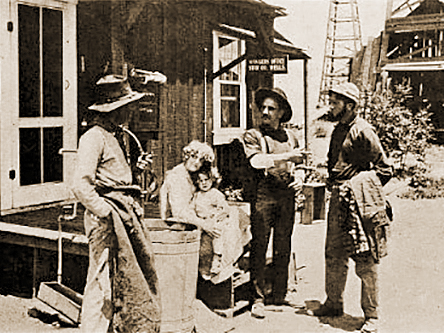| |
 |
| |
Photograph: Silent Era image collection.
|
For $200
Also known as [For $200.00] : {For Two-Hundred Dollars}
(1911) United States of America
B&W : One reel
Directed by [?] Gaston Méliès and/or Robert Goodman?
Cast: [?] Francis Ford?
G. Méliès production; distributed by The General Film Company, Incorporated. / Produced by Gaston Méliès. / Released 21 September 1911. / Standard 35mm spherical 1.33:1 format. / The production was shot at Santa Paula, California.
Drama.
Synopsis: [From Méliès promotional materials] An operation to restore Scotty’s little girl’s sight would cost two hundred dollars. Scotty had neither the money nor a job, but set out into the world with a firm determination to “make good”. Success came in an odd manner, far different than he had expected. Scotty obtained work to be sure, but it was an unselfish act of heroism that gained for him the reward of the grateful, and indirectly his daughter’s happiness. • [?] [From The Moving Picture World]? Scotty’s only daughter, Ethel, was becoming gradually blind. Doctors made an examination, and concluded that an operation was necessary to save the girl’s sight, the cost of which would be two hundred dollars. Scotty had not the required sum and to make things worse, lost his job at the factory. At this state of affairs, Scotty, determined to save Ethel from a bitter life, set out into the world to find work. His wanderings led him to an oil well, where a goodly foreman pressed him into service. It was not long before Scotty was sent out on a special job near the wells. Meanwhile, the foreman’s little girl had started from her mother’s side and wandered to dangerous ground near a cliff. Scotty saw the little one and risked his own life to rescue her. He climbed the treacherous precipice and carried the child safely to the wells. His heroic act was witnessed by the frantic mother through a surveying instrument. At the wells Scotty fell, exhausted, and was carried to the foreman's house. On regaining consciousness he told of his own little girl back home becoming more and more blind every day, and to save whom he was struggling. His tale struck deep into the hearts of the men, all of whom had witnessed his valiant deed. It was voted to lake a collection, and, with the foreman as the largest contributor, Scotty was enabled to save his daughter from a calamity shortly worse death.
Reviews: [The Moving Picture World, 14 October 1911, page ?] It is not the use of old facts that makes a picture trite; for works of art that are truly human remain young forever. It is the use of conventionalities in place of first-hand observation of life that makes a story or a picture uninteresting. The hero of this picture needed $200 to cure his daughter of blindness. This situation is entirely trite, but the picture doesn’t depend upon it. Its purpose is to draw in profile a phase of life and show something of the common bond of sympathy that unites men. The man, seeking work, gets a job at an oil well, and shortly after is the means of saving the life of his foreman’s little girl. It is a heroic act, and the workmen at the well, when they hear of his own child’s pitiful predicament, led by the foreman, put in the hat passed by the foreman’s wife the funds necessary to have the girl’s eyes attended to. This part of the story is fresh. The scenes that show the cure of the child’s eyes are wholly conventional and if they had been simply omitted, it would have helped the picture.
Survival status: (unknown)
Current rights holder: Public domain [USA].
Keywords: Blindness - Oil fields.
Listing updated: 26 May 2024.
References: Thompson-Star p. 230 : ClasIm-226 p. 55 : Website-IMDb.
|




































